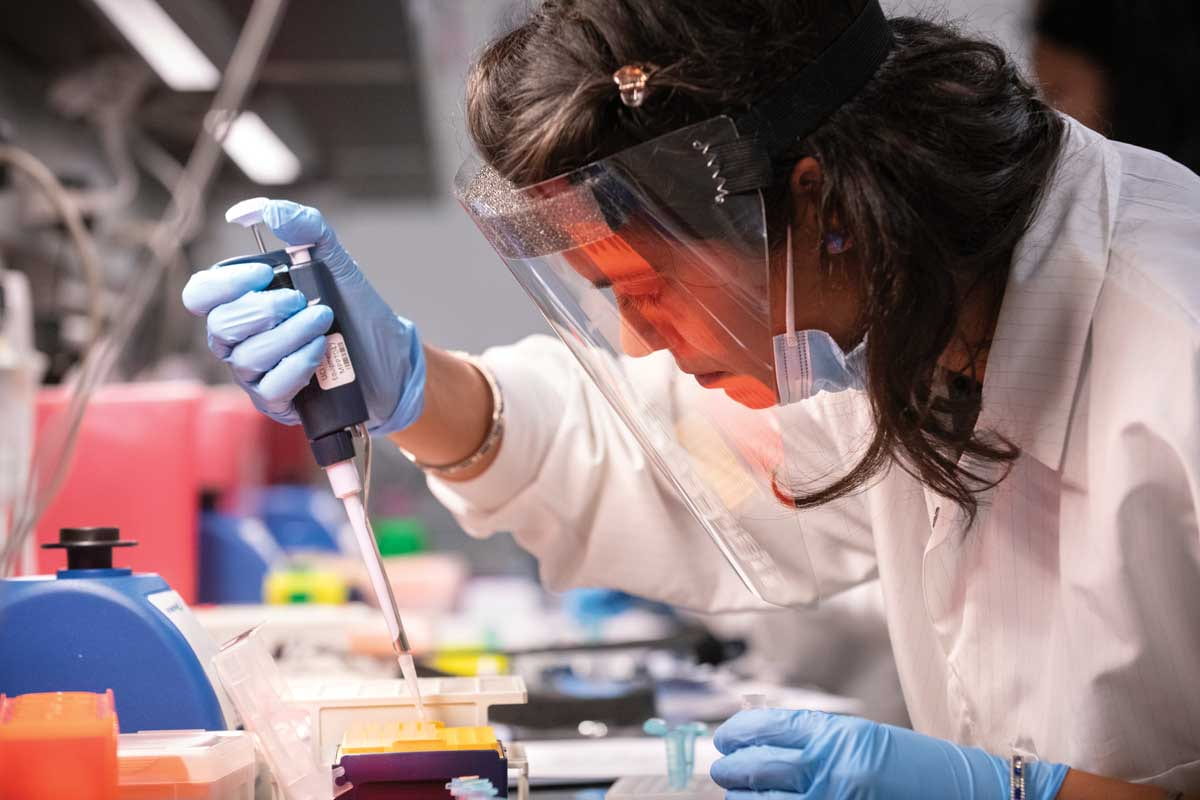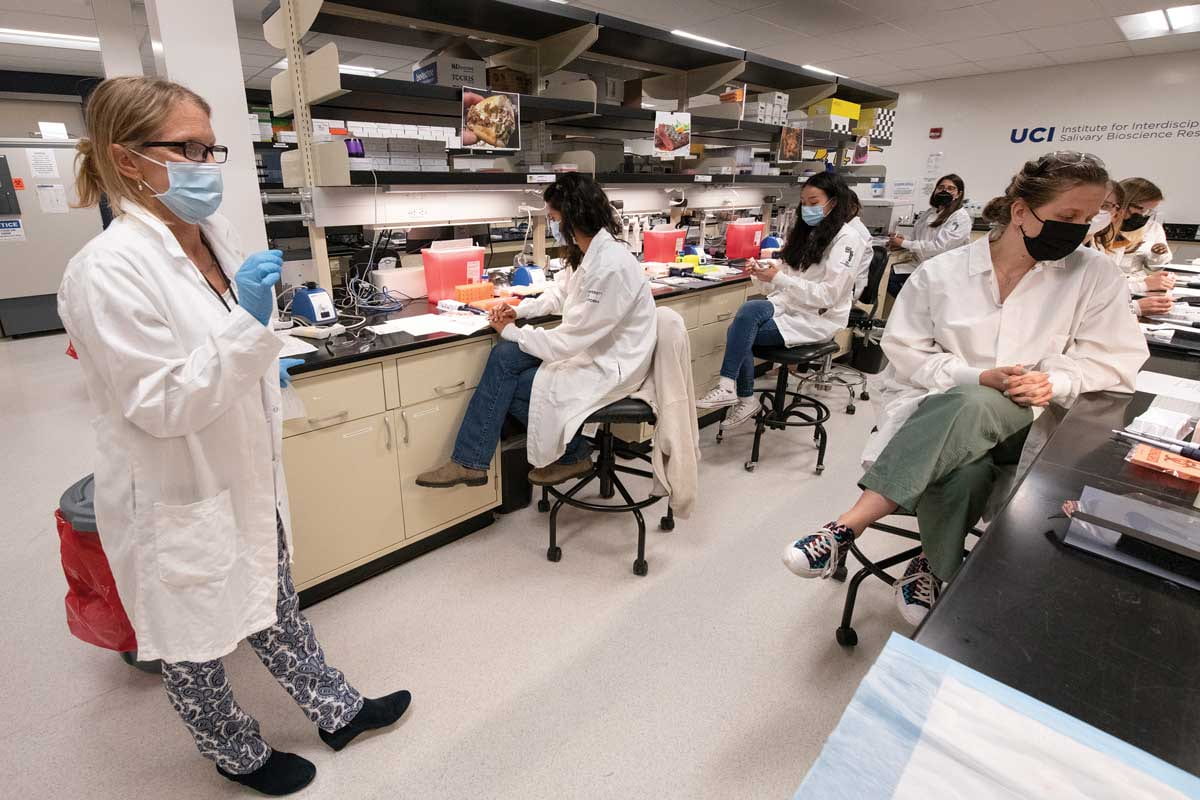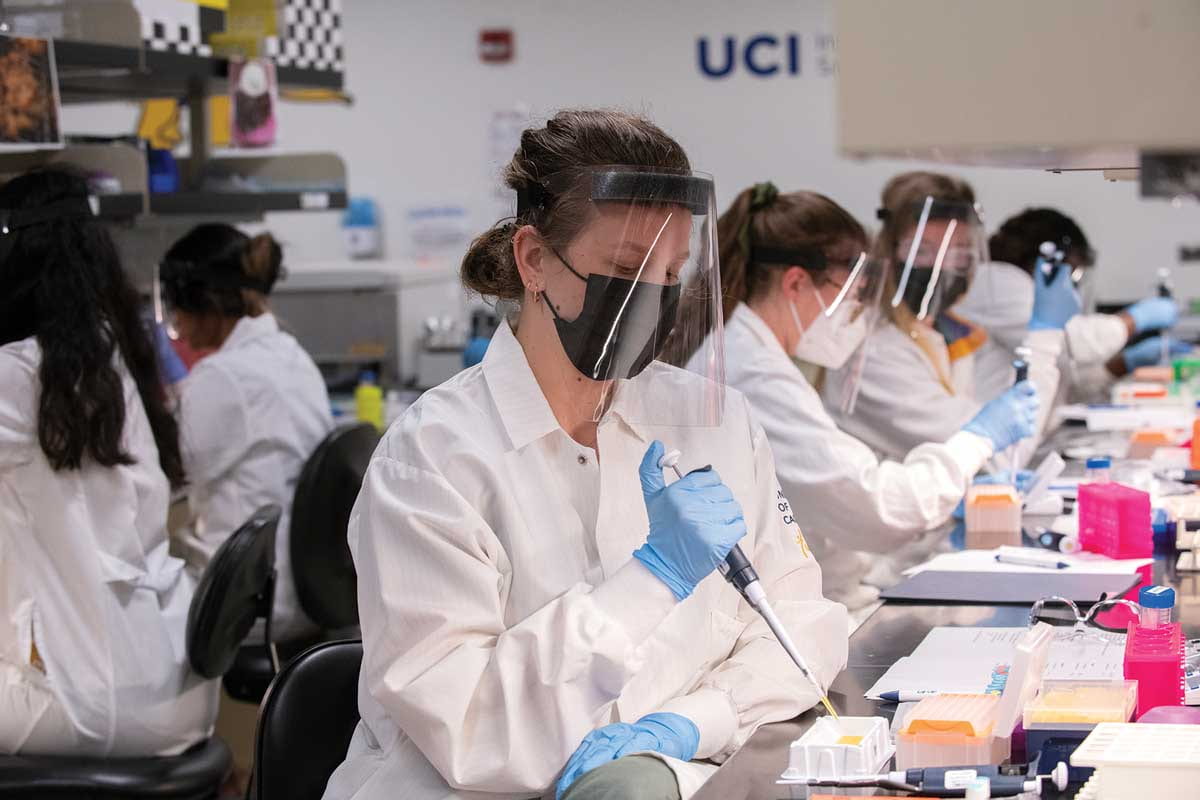
A salivating prospect
Participants at Spit Camp get hands-on experience collecting biospecimens and learning how ‘the diagnostic fluid of the future’ provides a window into the body
It’s not something you hear every day in a learning environment: “You should have no more saliva on your desk,” instructor Elizabeth Thomas told her eight students.
No, the students weren’t nodding off and drooling during a boring lecture in a UCI lab. Rather, during a recent two-day educational experience called Spit Camp, the participants had just taken samples of their own saliva and stored them for later analysis.
They were in the middle of a lab session on day one of Spit Camp at UCI’s Institute for Interdisciplinary Salivary Bioscience Research, a mouthful of a name and one of the only labs worldwide exclusively devoted to studying saliva biospecimens.
Yes, a lab singularly devoted to spit.
Sure, saliva may be disgusting. But it’s poised to become the diagnostic fluid of the future, according to IISBR co-directors Michael Hoyt and Jenna Riis.
That’s because spit is packed with DNA, enzymes, hormones, immune system markers and other substances that can provide clues to what’s happening in the body. And it’s a minimally invasive alternative to drawing blood.

IISBR conducts salivary bioscience research and educates, trains and consults researchers, physicians, caregivers, veterinarians, psychologists and other professionals on collecting and analyzing spit samples.
The institute fosters a team-science approach that promotes innovative, interdisciplinary research, says Riis, assistant professor of psychological science. “This shared method helps advance really new and interesting questions that come about when you have people from different fields talking together,” she says. “The training and research we do here is unique. And I don’t know of any other university or institution that offers a Spit Camp like ours.”
For newbies and experts

Among the many books in the IISBR lab in the School of Social Ecology and the Program in Public Health is an illustrated paperback aimed at younger readers called Spit: What’s Cool About Drool.
Each year, the average person produces enough saliva to fill two bathtubs, according to the book. Chew on that. The IISBR lab includes 13 freezers that, combined, can hold nearly 420,000 samples of spit. The specimens are stored in 1.7-milliliter containers (.06 fluid ounces) and kept at minus 80 C (minus 112 F). By comparison, a typical household freezer is minus 18 C (0 F).
The lab offers professional assay services to clients around the world who want to measure such things as cortisol, the body’s main stress hormone; alpha-amylase, another marker for stress; estradiol, the major female sex hormone; melatonin, a hormone the brain produces in response to darkness; uric acid, a waste product found in blood; testosterone; and much more.
Spit Camp is designed for newcomers to this type of research, such as undergraduates, as well as experienced scientists. Participants come from a wide range of disciplines, with psychology and public health being the most common, says Hoyt, a clinical and health psychologist and associate professor of population health.
Most of the eight participants in the two-day August Spit Camp (a third day, all virtual, was optional) were graduate students at other universities. Daria Kotov flew all the way from Boston to attend. She’s a Ph.D. student entering her second year in the developmental and brain sciences program at the University of Massachusetts Boston.
A professor recommended that she attend since her current research involves studying saliva. Kotov, who is from Irvine, is working with an existing data set including salivary biomarkers that she hopes to pull new ideas out of, she says. “Salivary research requires a lot of reading, but it’s usually not something you really get your hands on,” Kotov says. “It’s really cool to finally be on the participant side of being asked to contribute saliva in addition to learning the protocols associated with it.”
Food for thought
Day one of Spit Camp in the Social Ecology 1 building started off with lectures and ended with a tour of the lab where students collected their own spit. Wearing white lab coats, face shields, masks and gloves, they were introduced to the fundamentals of using a pipette, a tool to transport a measured volume of liquid, and had a pipetting practice session before they got down to the business of working up a decent volume of spit.
Each first inserted a swab into his or her mouth, with the goal of producing 1 milliliter of spit. To help induce a decent mouthful of drool, pictures of food were placed above their workstations: a medium-rare steak, chocolate cake, a Philly steak sandwich, cheese pizza, water with lemon slices, peach cobbler. The sight or smell of something delicious causes the rapid release of what’s called cephalic saliva.
Participants were tasked with collecting spit from different areas of the mouth, such as near the parotid glands, which sit just in front of the ears on each side of the face, as well as “passive drool,” which is exactly what it sounds like.
They repeated the collection of specimens that night before bed, when they woke up the next morning and 30 minutes after that to measure any changes in their levels of cortisol and alpha-amylase.
Stressor tests

The saliva collection began late on the afternoon of day one at Spit Camp. After harvesting the fluid while relaxed, the students dunked their hands in ice water to induce stress, keeping them submerged for at least one minute and up to five minutes.
This is known as a cold pressor test, which measures changes in blood pressure and heart rate related to vascular response and pulse excitability.
“It’s painful,” Thomas, IISBR operational director and a researcher in UCI’s Department of Epidemiology, told the participants as they began the cold pressor test. “I’m not going to lie. It’s not a walk in the park.”
Most of the “Spit Campers” yanked their hands out of the water in a minute or less before collecting more saliva. Kotov became an instant Spit Camp legend for keeping her hand in the ice water for five minutes. “This particular task is not stressful for me,” she declared.
Sure enough, the next day her saliva showed no change in her body’s cortisol level after the cold pressor test. Data from a random selection of 20 past Spit Campers showed, on average, a 63 percent increase in cortisol from pre- to post-ice task. Kotov, it turned out, is one cool customer.
Many Potential Benefits
At this stage, saliva samples have yet to be used to diagnose diseases.
“But that’s certainly a direction we may be heading,” says Hoyt. “Right now, spit is providing a really good window into the body.”
To cite just a few current uses, saliva is being analyzed to: measure a person’s stress level, exposure to such toxins as metals, immune system function (by checking proinflammatory cytokines), and amount of testosterone or estrogen; extract DNA; gauge the extent of head trauma; and understand the risk factors for certain diseases, including bipolar disorder, schizophrenia and Huntington’s disease.
Outside these uses, drool research is being conducted as a tool in various disciplines, such as economics, psychology, sociology, anthropology, gerontology, social work, sports medicine and psychiatry.
Saliva tests also are being employed in animal research – say, to determine the impact of a change in diet, social grouping, enclosure, schedule or routine. “There are so many different types of markers we can look at in saliva, which makes it an increasingly useful tool,” Hoyt says.
Salivary bioscience allows researchers to gauge the body’s response to adversity over time with minimal burden to participants, Riis notes.
For example, she says: “You could do a blood test in the clinic and then send a patient home with a saliva testing kit to do repeated or long-term tests on changes in multiple physiological systems and their effects on mental and physical health.
“Also,” she continues, “researchers could go into a community and take a bunch of saliva specimens at the same time and assess a lot of people who may have been exposed to something – such as pollutants, toxins or viruses – instead of hauling them into a clinic repeatedly.”
“There are so many different types of markers we can look at in saliva, which makes it an increasingly useful tool.”
IISBR co-director Michael Hoyt
More spit camps planned
The recent Spit Camp was the second this year following a two-year shutdown caused by the COVID-19 pandemic.
The IISBR got running in 2017 and was led by Doug Granger, a professor emeritus of psychological science who, along with Hoyt and Riis, is among eight core faculty members – three from public health and five from psychological science – who are involved in the lab. Due to demand, more Spit Camps are planned in the 2022-23 academic year.
One August participant was Asha Putnam, a graduate student at the University of Nevada, Reno who’s entering her third year as a Ph.D. student in clinical psychology. “I’ve always loved science,” says Putnam, who wants to become a professor and have her own therapy practice. The Bay Area native, who earned a bachelor’s degree in neuroscience at UNR, heard about Spit Camp from her academic advisor.
With a background in mindfulness and yoga, she wants to incorporate holistic methods in her therapy, focusing on people who have been exposed to trauma.
“I plan to use saliva as a research methodology,” Putnam says. “I plan to analyze their saliva to see if breathing exercises, for example, will lower their stress level and help them focus and feel better.” She highly recommends Spit Camp: “All the instructors are so friendly and welcoming, and it didn’t matter where you were in your knowledge base. I’m absolutely learning a lot here.”
“You could do a blood test in the clinic and then send a patient home with a saliva testing kit to do repeated or long-term tests on changes in multiple physiological systems and their effects on mental and physical health.”
IISBR co-director Jenna Riis
Saliva facts: Did you know?
- You have six salivary glands.
- Saliva is 99 percent water.
- Without saliva, you couldn’t taste.
- Saliva acts as a warning before you vomit.
- Saliva has healing properties.
- Saliva production varies from person to person, but in general, your salivary glands produce 2 to 4 pints of spit every day.
- Saliva starts the digestive process.
- Swapping spit exchanges millions of bacteria.
- Saliva has been used for diagnostic purposes in cultures dating back thousands of years.
- Saliva from nonhuman species can also be used to measure many of the same biomarkers.
- A lack of spit was once seen as an admission of guilt.
Source: UCI’s Institute for Interdisciplinary Salivary Bioscience Research


